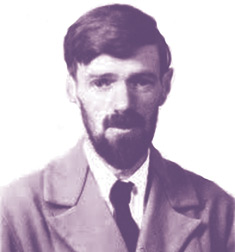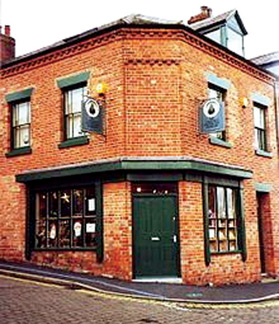How Lawrence analyses human relations in his novels
by W.T.J.S. Kaviratne-Ambalangoda spl. Cor.
D.H. Lawrence was a novelist, poet, short story writer, critic,
dramatist and painter. The major theme in the majority of his novels and
short stories is based on the issues relevant to a wider diversity of
human relationships.
In the short story, 'Odour of Chrysanthemum' the impact of unhappy
relationship developed between the protagonist Elizabeth Bates and her
husband Walter is depicted. Lawrence who had an intimate knowledge and
childhood experience about the lives of coal miners had provided him
authentic material for the themes of his works.
The strained relationship between Lawrence's mother and father and
the isolation and the negligence of his mother by his father and the
unhealthy atmosphere prevailed in the house have been vividly displayed
in 'Odour of Chrysanthemum'.
|

D.H. Lawrence |
Even Lawrence's father just like Walter, the husband of Elizabeth,
made village pub the primary destination after work and not the family
home. Lawrence focussed on how industrialisation and modernism had a
negative impact on human emotions, feelings and healthy relationships.
Third novel
'The Rainbow' is the third novel written by Lawrence in 1915 and its
main theme is the relationships among men and women of Brangwen family
in Est Midland. The consequences of the lack of understanding which
prevented the fulfilment of personal relationships and how it reacted on
their lives are highlighted.
Annu attacks the religious sensibility of Will while Ursula was
critical of the narrow-mindedness of Skrebenskys. Tom and Lydia Brangwen
who had hailed from different social, intellectual and cultural
backgrounds found it difficult to adjust their relationships. Ann who
was Lydia's daughter from her first husband had a dehumanising
relationship with her husband Will Brangwen who was a distant cousin of
Tom.
They had many children but their relationship had problems and
finally their marriage ended in failure. Will and Ann's daughter Ursula
who became a teacher had a relationship with a soldier Anton Skrebensky
but there was no satisfaction in their relationship. The narrator of
'Rainbow' focuses on relationships between its characters. Lawrence who
was an expert on exploring conscious and subconscious minds tried to
trace the traits of sexuality theory of Sigmund Freud's 'Oedipus Complex
' in mother - son relationship highlighted in "Sons and Lovers". He
revealed the mother - son relationship found between Paul and William
and their mother.
Mother and son
According to Lawrence in Sons and Lovers Gertrude Morel's
relationship with her sons Paul and William was exceptionally beyond the
conventional mother-son relationship or love. Mrs. Morel's relationship
mostly with her son Paul and to a lesser extent with the other son
William was so intense she did not approve the interest shown by their
girlfriends on them. Paul's relationship with Miriam was destroyed not
only by Miriam's deep spiritual relationships but by his mother's
disapproval and jealousy.
Mrs Morel hated the life she had lived with her husband and Lawrence
revealed the relationship she had with her husband was replaced by the
emotional relationships with her sons.
When Mr. Walter Morel died she strongly lacked the natural feelings
of sorrow and grief in the manner an ordinary wife should have felt on
the death of her husband. Mrs. Morel was highly worried when her son
William was leaving her to go to London.
Lawrence had used symbols of estranged relationship found between
husband and wife in Morel family. He had very effectively used symbols
relevant to the theme of the novel ' Sons and Lovers' depicting the
nature of relationships of its characters. Lawrence had used nature and
flowers as well as objects as effective symbols to portray the intense
sexual relationships in 'Sons and Lovers'.
Lawrence had used the symbol of Ash Tree, in Sons and Lovers to
portray the sinister and dark aspect of life and the mysterious forces
of nature which had been identified by Lawrence as forebodings of
tragedy in humanity. "A large splashed stars the roses gleamed on the
darkness of the foliage and stems and grass. Paul and Miriam stood close
together, silent and waited.
Point after point the roses shone out to them seeming to kindle
something in their souls. "The description of the flowers and their
intense whiteness Lawrence had exploited to portray the sexual
relationship and the emotions found emerging within Paul and Miriam. The
swing found In the Willey Farm was a symbol of 'love-hate' relationship
found between Paul and Miriam.
The back and forward movements of the swing portrayed the extremes of
their relationship. Paul loved Miriam one moment and hated another
moment. The thwarted relationship between Paul and Miriam in Sons and
Lovers was portrayed using the symbol hens.
Controversial
'Lady Chatterley's Lover' is the most controversial novel written by
D. H. Lawrence in 1928 and it was banned both in England and America as
pornographic. It was considered then as an explicit description of sex
in un-printable words.
Constance Reid (Lady Chatterly) the female protagonist of the novel
'Lady Chatterley's Lover' belonged to an upper-middle class family and
in 1917, at age of 23 she got married to Clifford Chatterley a scion of
an aristocratic family.
After a month of honeymoon he joined the war and returned home
paralysed, from waist down due to a war injury. After the war Clifford
Chatterley became a successful writer and was deeply engaged in his
literary activities and met writers at home. He found no time to be with
Constance and she felt that she had been completely ignored by Clifford.
Due to the fact that she and her husband Clifford were distanced a
nurse called Mrs. Bolton was hired to take care of handicapped Clifford.
|

D. H. Lawrence Birthplace Museum |
Constance was highly affected by the psycho-sexual emotional crisis
due to isolation. Her sexual frustration led her into a love affair with
their gamekeeper Oliver Mellors. Lady Chatterley (Constance) had
realised that she could no longer live with the mind alone. She must
also be alive physically.
Diversity
Lawrence conveyed another relationship which he advocated 'mind -
body relationship in the novel through the sexual relationship of Lady
Chatterley with the gamekeeper Oliver Mellors.
Lawrence analysed diversity of relationships existed between the
characters of gamekeeper Oliver Mellors and his wife Bertha which was of
brutal sexual nature, maternal relationship between Clifford Chatterley
and his nurse Mrs. Bolton in the novel Lady Chatterley's Lover.
All the characters in ' Lady Chatterley's Lover ' appeared to be in a
great struggle in searching for meaningful relationships. The main plot
of the novel revolves around Constance Chatterley's (Lady Chatterley)
relationship with the gamekeeper Oliver Mellors and decline of the
relationship with her husband Clifford Chatterley.
Each character was dissatisfied with their previous relationships due
to lack of harmony between the mind and the body.
Lady Chatterley lacked intimacy with her husband Clifford Chatterley
because he was only 'mind' and strongly lacked 'body' because he was
physically handicapped and impotent.
The gamekeeper Oliver Mellors kept away from his wife Bertha due to
her brutish sexual nature. These different dissatisfactions eroded the
healthy relationships between the characters of 'Lady Chatterley's
Lover'. Some literary critics referring to the sexual aspects of 'Lady
Chatterley's Lover' are of the opinion that they are merely symptomatic
of deeper issues that D.H. Lawrence exposes.
Lawrence aimed primarily to expose the dehumanisation of
industrialisation of England. A symmetrical relationship between the
characters, the social class and the scarred landscapes had been created
by Lawrence to reinforce his major theme of 'human relationships' in
Lady Chatterley's Lover.
Lawrence as usual was not hesitant to attribute the unhealthy human
relationships existed among the people in England to industrialisation
in the 19th century. Clifford Chatterley became a war victim, a cripple
and the failure of his marriage to Constance were all direct results of
industrialisation. |

